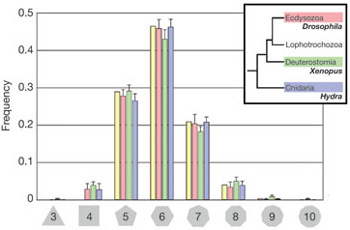
This month's topics:
The Geometry of Musical Chords.
This is the title of a report in the July 7 2006 Science, written by Dmitri Tymoczko, Professor of Music at Princeton. The abstract begins: "A musical chord can be represented as a point in a geometrical space called an orbifold. Line segments represent mappings from the notes of one chord to those of another." The simplest example of this representation is for the case of intervals, or two-note chords. As Tymoczko says, "Human pitch perception is both logarithmic and periodic." We judge the distance between tones in terms of the ratio of their pitches, and identify tones when that ratio is 2. So the psychological space of tones is a circle, where we can mark off 12 equidistant points corresponding to the pitch classes C, C#, D, ... , A#, B. It is convenient to identify this circle with T1 = R/12Z and to place the equal-tempered pitches at the integral points 0 (C), ... 11 (B). Then the space of pairs of tones is the torus T1 × T1 and the space of intervals (unordered pairs) is the quotient of this torus by the relation (x,y) ~ (y,x). The result is a Möbius strip, a manifold with boundary and thus an orbifold.

The identification (x,y) ~ (y,x) makes the torus into a Möbius strip, a manifold with boundary.
Here is how the intervals appear on the Möbius strip:
The 2-note chords, or intervals, as they appear on the Möbius strip of unordered tone pairs. "t" is 10 and "e" is 11. 70=07 corresponds to the fifth chord C-G. Transposition corresponds to sideways motion. "Voice leading," i.e. motion through chords, is represented by paths on the surface: e.g. C-G → D-F# is represented by the arrow 70 → 16. Note that the voice leading C-C# &rarr C#-C reflects off the upper boundary. Image courtesy Dmitri Tymoczko.
For three or four-note chords the topology becomes more complicated. For example three-note chords live on the 3-dimensional orbifold constructed by taking a 3-dimensional prism with base a triangle, twisting the base so as to cyclically permute the vertices, and identifying it with the opposite face. But it makes musical sense: "Chords that divide the octave evenly lie at the center of the orbifold and are surrounded by the familiar sonorities of Western tonality."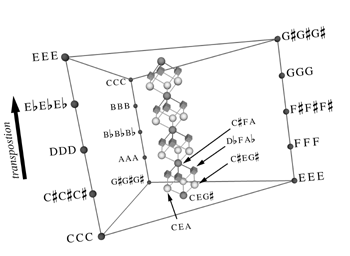
The 3-dimensional orbifold representing the space of 3-note chords. "Chords that divide the octave evenly lie at the center of the orbifold and are surrounded by the familiar sonorities of Western tonality." Image courtesy Dmitri Tymoczko.
It is clearly Tymoczko's intent for these representations to serve not only as a tool in musical analysis, but also as a stimulus for new directions in composition. More information, including free ChordGeometries software, on his website. Epithelial topology.Epithelial tissue is typically a 2-dimensional array of cells. Topologically
the average cell shape must be a hexagon. Remarkably,
an identical, assymetric distribution
of polygonal shapes shows up over an enormous range of organisms.
Drosophila is a fly,
Xenopus is a frog and Hydra is a tiny fresh-water relative
of jellyfish.

"Drosophila wing disc (pink), Xenopus tail epidermis (green) and Hydra epidermis (blue) all exhibit a similar non-gaussian distribution of epithelial polygons with less than 50% hexagonal cells and high (and asymmetric) percentages of pentagonal and heptagonal cells. The inset indicates relative phylogenetic positions for Drosophila, Xenopus and Hydra." Yellow bars represent the theoretical distribution derived in this article (see below). Image from Nature 442 1038-1041, used with permission.
A theoretical explanation for this phenomenon is given in "The emergence of geometric order in proliferating metazoan epithelia," by Matthew Gibson (Harvard) and collaborators, in Nature for August 31, 2006. It relies on the observation that when a cell in a 2-dimensional array divides, each of its daughters typically has one fewer neighbor, while two of its neighbors pick up an extra side.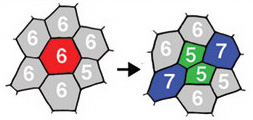
Typically the daughters of a hexagonal cell are pentagons, while two hexagonal neighbors become heptagons. Image from Nature 442 1038-1041, used with permission.
To study the way the distribution of polygonal types changes under repeated subdivisions, Gibson and his colleagues axiomatize the situation (each of these statements is given an experimental justification).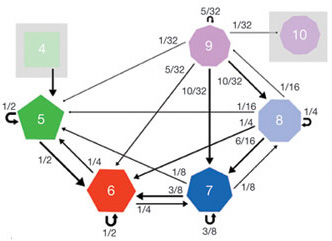
Markov-chain model for the change in polygonal type from one generation to the next. Image from Nature 442 1038-1041, used with permission.
Mathematical error control.Barry Mazur has a "News and Views" piece in the September 7 2006
Nature about recent steps towards the proof of the Sato-Tate
conjecture, which predicts the distribution of the error
terms in good approximations for solutions of combinatorial
number-theoretic problems. These are not the errors that plague natural
scientists measuring things out in the field, but the report is
a work of art. Mazur illustrates the conjecture with a nice, and elementary,
example. The problem here is to count the number N(p) of
ways a prime number p
can be written as a sum of 24 squares of integers. Note that zero and
negative numbers are allowed to participate, and that all permutations
of the terms in a sum must be counted as different "ways." So
N(2) is already 1,104. Now there exists
a good approximation A(p) for N(p):
 ,
good in the sense that
the error scales like the square root of N;
in fact there is an explicit least upper bound for the error as a
function of p:
,
good in the sense that
the error scales like the square root of N;
in fact there is an explicit least upper bound for the error as a
function of p:
 .
For problems like this, the Sato-Tate conjecture predicts that the distribution
of the scaled error
.
For problems like this, the Sato-Tate conjecture predicts that the distribution
of the scaled error

 ,
whose graph is a semi-circle normalized to have area 1.
,
whose graph is a semi-circle normalized to have area 1. 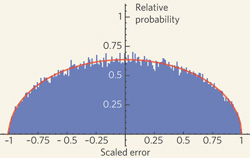
The scaled error distribution for N(p) predicted by the Sato-Tate conjecture (red curve) and the actual distribution for primes less than one million. Image from Nature, 443 38-40, used with permission.
For this case of the conjecture the evidence is excellent but there is as yet no proof. Mazur mentions a class of problems, related to elliptic curves, where the conjecture has in fact been proved (through the efforts of his Harvard colleague Richard Taylor and Taylor's collaborators). As Mazur explains it, "The proof came by combining some wonderful pieces of mathematics, and the key to it is all is so-called representation theory. This branch of mathematics, in its various guises, studies abstract groups by representing them as groups of linear transformations of vector spaces. By understanding the profound number-theoretic structure behind enough of the symmetric tensor powers of a certain representation of a certain group, one can compute the probability distribution of the corresponding scaled error terms, and so confirm the Sato-Tate conjecture."